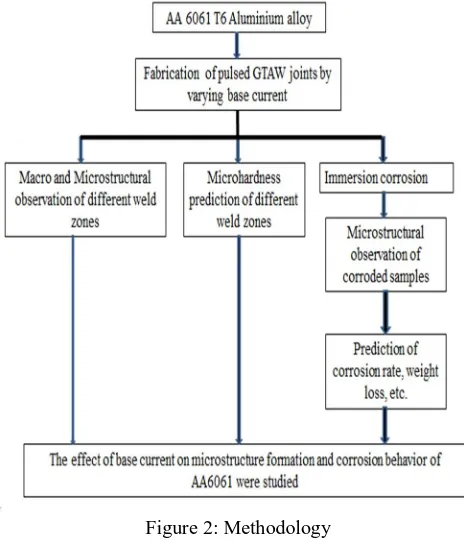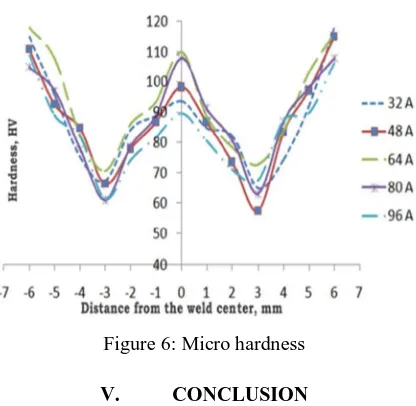Technology (IJRASET)
An Investigation on Effect of Process Parameter of
Pulsed Tig Welded Aluminum Alloy on Mechanical
and Corrosion Properties
Mr .C. Parthasarathy 1, Mr. D. Sathyaseelan 2
Assistant Professor, Department of Mechanical, Arasu Engineering college, Kumbakonam , Tamilnadu1 Assistant Professor, Department of Mechanical, Arasu Engineering college, Kumbakonam , Tamilnadu2
Abstract: Aluminium 6061 alloy is commonly used for construction of aircraft structures, such as wings and fuselages, more commonly in homebuilt aircraft than commercial or military aircraft. AA 6061-T6 aluminum alloy is widely applied because of its beneficial properties like light weight, corrosion resistance, high strength to weight ratio, low cost, etc. The pulsed current gas tungsten arc welding (PCGTAW) is widely used for quality welding of aluminium alloys in the large structures.Determination of the heat input by varying the base current and the subsequent effect on micro structural and micro hardness formation is investigated. From this investigation it was found that the joint made from the PCGTAW yielded superior tensile properties and impact strength due to the higher hardness and fine microstructure.
Keyword: PCGTAW, Aluminium AA 6061-T6, Microstructure, Welding.
I. INTRODUCTION
In recent years, demands for aluminium alloy 6061 have steadily increased in aerospace, aircraft and automobile applications because of their excellent strength to weight ratio, good ductility, corrosion resistance and cracking resistance in adverse environment. Welding of these alloys, however, still remains a challenge. GTAW is an arc welding process, where arc is produced between non consumable tungsten electrode and base metal. Pulsed GTA welding process is frequently used for welding of aluminium alloys as heat input during welding can be precisely controlled. This process is strongly characterized by bead geometry, which plays an important role in determining mechanical properties of the weld. Pulse process variables are controlling factor for heat input, which in turn leads to grain refinement in fusion zone, width reduction of HAZ, segregation of alloying elements, reducing hot cracking sensitivity and residual stresses.
Improved mechanical properties of weld are achieved by using current pulsing due to the grain refinement occurring in the fusion zone. The main aim of pulsing is to achieve+ maximum penetration without excessive heat built-up. The use of high current pulses is to penetrate deep and cater for longer arc period at lower current. Deep penetration in pulsed current welding is produced by arc pressure at peak for longer durations . In addition to this argon-helium gas mixture offers certain advantages by increasing heat input of the arc during welding.
A. Gas tungsten arc welding
Technology (IJRASET)
[image:3.612.190.415.101.245.2]used in robotics, although special techniques are needed when it is necessary to add filler metal to the weld pool.
Figure 1 GTAW machine
II. METHODOLOGY
Two specimen of 150 x 75 x 3 mm were prepared and butted together. The butt joints were created using varying base current in the pulsed GTAWwelding. The metallographic specimen are sectioned from the welded joint as per the ASTM standards. The specimens were polished and etched by the chemical etchant to reveal the macro and microstructures. The specimen subjected to metallographic test is used for the microhardness test Hence, determination of the heat input by varying the base current and the subsequent effect on microstructural and microhardness formation is investigated in this study.In addition, the corrosion behavior of varying process parameter is also predicted.The alteration in the grain size significantly influences the prone to corrosion of the welded samples. The magnitude of formation of etch pit and the type of corrosion prevail are predicted.
Figure 2: Methodology
[image:3.612.187.419.407.687.2]Technology (IJRASET)
[image:4.612.171.440.180.560.2]machining as like the geometric configuration (Figure 2). The chemical composition and mechanical properties of AA6061 T6 is shown in the table 1 and table 2 of the Square butt joint configuration was prepared to fabricate PCGTAW joints. The initial joint configuration was obtained by securing the plates in position using mechanical clamps. The direction of welding was normal to the rolling direction. Single pass welding procedure was used to fabricate the joints. Argon (purity 99.99%) was used as shielding gas. Figure 3 shows the experimental setup used for welding the joints. A constant welding speed of 1.06 mm/s was used in this investigation. A series of trails were carried out by varying the process parameters. The optimum working range of parameter is decided from the bead size and penetration. The process parameters used in this investigation is presented in the Table 3.
Table 1 Chemical composition (wt%) of aluminium alloy AA6061 –T6
Elements Mg Mn Fe Si Cu Al
wt% 0.689 0.331 0.230 0.531 0.305 Bal
Table 2 Mechanical properties of base metal and all weld metal
Table3 Process parameters
Parameters Values
Peak current, A 160
Background current, A 32, 48, 64, 80, 96
Pulse on time, s 50
Frequency, Hz 4
Speed, mm/s 1.06
IV. RESULTS AND DISCUSSION
Many trails are conducted to achieve the sound joints. The working limit of base current is identify based on the bead width, depth of penetration and bead height to width ratio.
A. Macrostructure
At the lower background current the heat input was 1.630 kJ/mm which was not sufficient to make full penetration. As the background current increased the heat input is increased which cause deeper and shallow weld bead. At heat input 1.91 kJ/mm optimum deep and wide weld bead is achieved. This fact was agreed by the finite element analysis. Further increase of heat input create shallow weld and larger HAZ region which is not favorable.
Yield strength (MPa) Ultimate tensile strength (MPa) Elongation (%) Vickers hardness (0.05 kg) (HV)
Technology (IJRASET)
Figure 3: Macrostructure
B. Microstructure
[image:5.612.189.427.363.701.2]The parent material consists of elongated grains having a average grain size in the range -100 μm . Weld fusion zones typically exhibit coarse columnar grains because of the prevailing thermal conditions during weld metal solidification. This often results in inferior weld mechanical properties andpoor resistance to hot cracking. It is thus highly desirable to control solidification structure in welds and such control is often very difficult because of higher temperatures and higher thermal gradients in welds in relation to castings and the epitaxial nature of the growth process. At 64 A relatively finer microstructure was observed than the other microstructures.
Figure 4: weld bead microstructure
Technology (IJRASET)
C. Microhardness [image:6.612.204.412.189.392.2]Figure 6 shows the microhardness plots for various base current parameters. The hardness of the material is dependent on its microstructure. So, hardness measurement would be an acceptable method to investigate the inhomogeneous microstructures. Details of optical microscope’s images of the different areas show significant difference in the microstructure of the regions which exhibit high and low hardness values. The finer microstructure yields higher hardness due to the increase in the boundary energy.
Figure 6: Micro hardness
V. CONCLUSION
From this investigation following conclusions were made If background current is lower than 64 A, then the arc length is found to be very short and addition of filler metal becomes inconvenient. On the other hand, if the background current is greater than 64 A, then arc becomes unstable and arc wandering is observed due to increased arc length. The optimum heat input of 1.901 kJ/mm at 64 A results in full penetration and yields higher hardness of 110 HV in the weld region. Immersion corrosion study was made and find
REFERENCES
[1] M. Balasubramanian , V. Jayabalan , V.Balasubramanian, “ Effect of Pulsed gas tungsten arc welding on corrosion behavior of Ti-6Al-4V titanium alloy Material Science Engineering” , Materials and Design volume 29(2008) pp 1359-1363.
[2] M.Balasubramanian,V.Jayabalan,V.Balasubramanian, “ Modeling corrosion behavior of gas tungsten arc welded titanium alloy Transactions of on ferrous Metal society of China” volume 17(2007) pp 676-680
[3] Dong Min, Jun Shen, Shiqiang Lai, Jie Chen, “Effect of heat input on the microstructure and mechanical properties of tungsten inert gas arc welded AZ61 magnesium alloy plates Material Characteristation” Volume 60 (2009)pp 1583-1590
[4] A. Kumar, S. Sundarrajan, “Optimization of pulsed TIG welded process parameter on mechanical properties of AA5456 Aluminium alloy weldments Materials and Design” volume 30(2009) pp 1288-1297.
[5] J.J wang ,T.Lin, “Obtaining weld pool vision information during aluminium alloy TIG welding Materials science and Engineering “ volume 26(2005) pp 219-227.



